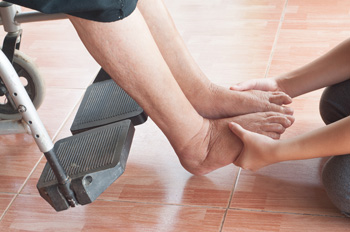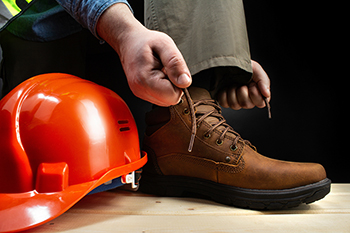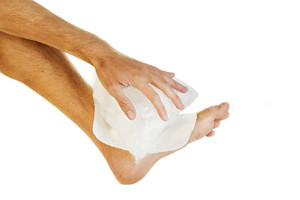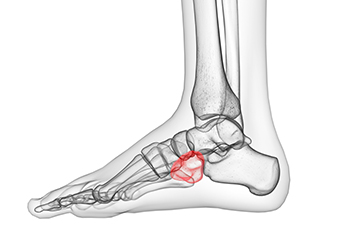Blog
 Gout, a type of arthritis that often affects the feet and toes, is caused by a buildup of uric acid in the bloodstream. About two-thirds of uric acid in the blood occurs naturally in the body, a product of the breakdown of cells. One-third of uric acid comes from eating foods that contain purines, chemicals that create uric acid as a byproduct when the body metabolizes them. When your body has high levels of uric acid, this substance can crystallize and lodge in your joints, causing painful gout flare-ups. Gout pain is typically sudden and severe, centered on an inflamed and swollen joint. If you have gout, it is suggested that you be under the care of a podiatrist.
Gout, a type of arthritis that often affects the feet and toes, is caused by a buildup of uric acid in the bloodstream. About two-thirds of uric acid in the blood occurs naturally in the body, a product of the breakdown of cells. One-third of uric acid comes from eating foods that contain purines, chemicals that create uric acid as a byproduct when the body metabolizes them. When your body has high levels of uric acid, this substance can crystallize and lodge in your joints, causing painful gout flare-ups. Gout pain is typically sudden and severe, centered on an inflamed and swollen joint. If you have gout, it is suggested that you be under the care of a podiatrist.
Gout is a foot condition that requires certain treatment and care. If you are seeking treatment, contact one of our podiatrists from Westside Podiatry Center, LLP. Our doctors will treat your foot and ankle needs.
What Is Gout?
Gout is a type of arthritis caused by a buildup of uric acid in the bloodstream. It often develops in the foot, especially the big toe area, although it can manifest in other parts of the body as well. Gout can make walking and standing very painful and is especially common in diabetics and the obese.
People typically get gout because of a poor diet. Genetic predisposition is also a factor. The children of parents who have had gout frequently have a chance of developing it themselves.
Gout can easily be identified by redness and inflammation of the big toe and the surrounding areas of the foot. Other symptoms include extreme fatigue, joint pain, and running high fevers. Sometimes corticosteroid drugs can be prescribed to treat gout, but the best way to combat this disease is to get more exercise and eat a better diet.
If you have any questions please feel free to contact one of our offices located in Liverpool, Camillus, Skaneateles, Oswego, and Cicero, NY . We offer the newest diagnostic and treatment technologies for all your foot and ankle needs.
Many older adults experience chronic cold feet, which can be helped simply by wearing warmer socks and different shoes or slippers. But there may be underlying reasons that can cause or contribute to this condition. For instance, if you have diabetes, high blood pressure, or hardening of the arteries, the blood flow to your feet through narrowed arteries may be obstructed. Further, nerve damage, which also may be a result of diabetes, can cause your feet to be cold, numb, or prickly. And if you are a smoker, your blood vessels may constrict and reduce the circulation to your extremities. Finally, sitting for long periods can result in poor blood circulation to your feet, causing them to feel cold. If you notice a regular occurrence of cold feet, it is a good idea to make an appointment with a podiatrist who can review your health history, examine your feet and suggest treatment options.
Proper foot care is something many older adults forget to consider. If you have any concerns about your feet and ankles, contact one of our podiatrists from Westside Podiatry Center, LLP. Our doctors can provide the care you need to keep you pain-free and on your feet.
The Elderly and Their Feet
As we age we start to notice many changes in our body, but the elder population may not notice them right away. Medical conditions may prevent the elderly to take notice of their foot health right away. Poor vision is a lead contributor to not taking action for the elderly.
Common Conditions
- Neuropathy – can reduce feeling in the feet and can hide many life-threatening medical conditions.
- Reduced flexibility – prevents the ability of proper toenail trimming, and foot cleaning. If left untreated, it may lead to further medical issues.
- Foot sores – amongst the older population can be serious before they are discovered. Some of the problematic conditions they may face are:
- Gouging toenails affecting nearby toe
- Shoes that don’t fit properly
- Pressure sores
- Loss of circulation in legs & feet
- Edema & swelling of feet and ankles
Susceptible Infections
Diabetes and poor circulation can cause general loss of sensitivity over the years, turning a simple cut into a serious issue.
If you have any questions please feel free to contact one of our offices located in Liverpool, Camillus, Skaneateles, Oswego, and Cicero, NY . We offer the newest diagnostic and treatment technologies for all your foot and ankle needs.
Here are a few tips on finding the perfect fit in your work boots or work shoes. First, the shoe/boot should be snug, but not tight. The back of the shoe or boot should hug (but not cut into) the heel, and the ball of your foot should lay comfortably in the ball of the shoe. There should be space between the tips of the toes and the toe box. Your toes should have enough room to move a bit and they should never be squeezed or confined. Work shoes and boots that fit properly will keep you energized and even help your footwear last. For more tips on work footwear or to learn about custom orthotics that can keep your feet comfortable and healthy, contact your local podiatrist.
It is important to find shoes that fit you properly in order to avoid a variety of different foot problems. For more information about treatment, contact one of our podiatrists from Westside Podiatry Center, LLP. Our doctors will treat your foot and ankle needs.
Proper Shoe Fitting
Shoes have many different functions. They cushion our body weight, protect our feet, and allow us to safely play sports. You should always make sure that the shoes you wear fit you properly in order to avoid injuries and deformities such as: bunions, corns, calluses, hammertoes, plantar fasciitis, stress fractures, and more. It is important to note that although a certain pair of shoes might be a great fit for someone else, that doesn’t mean they will be a great fit for you. This is why you should always try on shoes before buying them to make sure they are worth the investment. Typically, shoes need to be replaced ever six months to one year of regular use.
Tips for Proper Shoe Fitting
- Select a shoe that is shaped like your foot
- Don’t buy shoes that fit too tight, expecting them to stretch to fit
- Make sure there is enough space (3/8” to ½”) for your longest toe at the end of each shoe when you are standing up
- Walk in the shoes to make sure they fit and feel right
- Don’t select shoes by the size marked inside the shoe, but by how the shoe fits your foot
The shoes you buy should always feel as good as they look. Shoes that fit properly will last longer, feel better, and improve your way of life each day.
If you have any questions, please feel free to contact one of our offices located in Liverpool, Camillus, Skaneateles, Oswego, and Cicero, NY . We offer the newest diagnostic and treatment technologies for all your foot care needs.
Pain in the top of the foot can be caused from a variety of conditions, one of them being extensor tendinitis. Tendons are fibrous tissues that connect muscles to bone. Extensor tendons are located on the top of the feet. They connect bones in the toes to muscles on the front portion of the leg which work together to help raise your toes and flex your feet. These tendons can become inflamed and irritated from wearing tight, small, or non-supportive shoes, or from overuse. This condition, known as extensor tendonitis, can cause pain and swelling in the top of the feet that may worsen after activity. If you are experiencing this type of foot pain, it is a good idea to contact a podiatrist. After the examination, if it’s determined that you have extensor tendonitis, your doctor may prescribe a course of treatment that includes rest, anti-inflammatory medication, splinting, physical therapy, or even steroid injections.
Foot Pain
Foot pain can be extremely painful and debilitating. If you have a foot pain, consult with one of our podiatrists from Westside Podiatry Center, LLP. Our doctors will assess your condition and provide you with quality foot and ankle treatment.
Causes
Foot pain is a very broad condition that could be caused by one or more ailments. The most common include:
- Bunions
- Hammertoes
- Plantar Fasciitis
- Bone Spurs
- Corns
- Tarsal Tunnel Syndrome
- Ingrown Toenails
- Arthritis (such as Gout, Rheumatoid, and Osteoarthritis)
- Flat Feet
- Injury (from stress fractures, broken toe, foot, ankle, Achilles tendon ruptures, and sprains)
- And more
Diagnosis
To figure out the cause of foot pain, podiatrists utilize several different methods. This can range from simple visual inspections and sensation tests to X-rays and MRI scans. Prior medical history, family medical history, and any recent physical traumatic events will all be taken into consideration for a proper diagnosis.
Treatment
Treatment depends upon the cause of the foot pain. Whether it is resting, staying off the foot, or having surgery; podiatrists have a number of treatment options available for foot pain.
If you have any questions, please feel free to contact one of our offices located in Liverpool, Camillus, Skaneateles, Oswego, and Cicero, NY . We offer the newest diagnostic and treatment technologies for all your foot care needs.
Ankle pain is usually either injury/trauma-related, or due to a medical condition. Along with pain you may experience swelling, redness, bruising, numbness, stiffness, weakness, and the ankle may not be able to sustain any weight being placed on it. If ankle pain is present due to an injury, it can range from not serious, to moderately serious, to serious. Ankle pain/inflammation that is not serious usually fades quickly after the injury and responds to anti-inflammatory drugs, icing, and rest. Moderately serious ankle pain will typically last longer, however there may be no obvious injury. Serious ankle pain should be considered an emergency. Along with presenting an obvious injury or deformity, it is usually accompanied by redness and swelling. Typical ankle injuries include sprains, strains, fractures, and Achilles tendon injuries. Medical conditions that contribute to ankle pain include rheumatoid arthritis, gout, bacterial infections, tumors, Osteochondritis dissecans, fibromyalgia, and more. Any pain in your ankle that lasts for more than a couple of days should be checked out by a podiatrist who has the experience and skills to diagnose and treat your condition.
Ankle pain can have many different causes and the pain may potentially be serious. If you have ankle pain, consult with one of our podiatrists from Westside Podiatry Center, LLP. Our doctors will assess your condition and provide you with quality foot and ankle treatment.
Ankle pain is any condition that causes pain in the ankle. Due to the fact that the ankle consists of tendons, muscles, bones, and ligaments, ankle pain can come from a number of different conditions.
Causes
The most common causes of ankle pain include:
- Types of arthritis (rheumatoid, osteoarthritis, and gout)
- Ankle sprains
- Broken ankles
- Achilles tendinitis
- Achilles tendon rupture
- Stress fractures
- Tarsal tunnel syndrome
- Plantar fasciitis
Symptoms
Symptoms of ankle injury vary based upon the condition. Pain may include general pain and discomfort, swelling, aching, redness, bruising, burning or stabbing sensations, and/or loss of sensation.
Diagnosis
Due to the wide variety of potential causes of ankle pain, podiatrists will utilize a number of different methods to properly diagnose ankle pain. This can include asking for personal and family medical histories and of any recent injuries. Further diagnosis may include sensation tests, a physical examination, and potentially x-rays or other imaging tests.
Treatment
Just as the range of causes varies widely, so do treatments. Some more common treatments are rest, ice packs, keeping pressure off the foot, orthotics and braces, medication for inflammation and pain, and surgery.
If you have any questions, please feel free to contact one of our offices located in Liverpool, Camillus, Skaneateles, Oswego, and Cicero, NY . We offer the newest diagnostic and treatment technologies for all your foot care needs.
There are many causes of heel pain, including bursitis. The retrocalcaneal bursa is a fluid-filled sac located between the heel bone and the Achilles tendon. It cushions and lubricates the tendon as it slides over the heel bone, while acting as a shock absorber during walking and other movements. Excessive walking, running, jumping or other stress inducing activities placed upon the ankle may cause this bursa to become swollen, irritated, and inflamed. The skin at the back of the heel may be warm or red. The affected area may also become very sensitive to the touch, and painful during physical activity or when standing on your toes. If you feel this type of pain at the back of your heel that does not improve with rest, it is in your best interest to schedule an appointment with a podiatrist. They will perform a physical examination and may recommend certain conservative treatments such as icing, anti-inflammatory medication, orthotics or heel wedges to reduce stress on the heel, ultrasound and/or physical therapy, or possibly even steroid injections if other methods do not work.
Many people suffer from bouts of heel pain. For more information, contact one of our podiatrists of Westside Podiatry Center, LLP. Our doctors can provide the care you need to keep you pain-free and on your feet.
Causes of Heel Pain
Heel pain is often associated with plantar fasciitis. The plantar fascia is a band of tissues that extends along the bottom of the foot. A rip or tear in this ligament can cause inflammation of the tissue.
Achilles tendonitis is another cause of heel pain. Inflammation of the Achilles tendon will cause pain from fractures and muscle tearing. Lack of flexibility is also another symptom.
Heel spurs are another cause of pain. When the tissues of the plantar fascia undergo a great deal of stress, it can lead to ligament separation from the heel bone, causing heel spurs.
Why Might Heel Pain Occur?
- Wearing ill-fitting shoes
- Wearing non-supportive shoes
- Weight change
- Excessive running
Treatments
Heel pain should be treated as soon as possible for immediate results. Keeping your feet in a stress-free environment will help. If you suffer from Achilles tendonitis or plantar fasciitis, applying ice will reduce the swelling. Stretching before an exercise like running will help the muscles. Using all these tips will help make heel pain a condition of the past.
If you have any questions please contact one of our offices located in Liverpool, Camillus, Skaneateles, Oswego, and Cicero, NY . We offer the newest diagnostic and treatment technologies for all your foot and ankle needs.
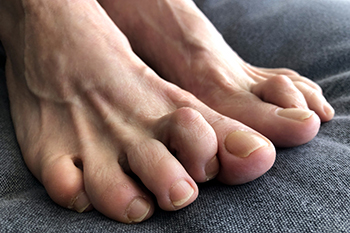 Hammertoes, claw toes, and mallet toes all result from the toes getting bent into odd positions. They usually look odd or unsightly, and they typically affect the smaller toes. When the toe is bent downward and the middle joint raises up, this is known as a hammertoe. This condition frequently affects the second toe and sometimes coincides with a bunion. Claw toes occur when the toes curl up due to the middle joints being bent down, and they often affect all four smaller toes at the same time. When the joint closest to the tip of the toe bends downward, it forms what is known as a mallet toe. Wearing shoes that are too tight is most commonly blamed for these conditions arising, but they can also be linked to diabetes or arthritis. These toe ailments can be quite painful, so patients who are struggling with one would be wise to consult with a podiatrist who can help find a treatment option and determine if surgery is necessary.
Hammertoes, claw toes, and mallet toes all result from the toes getting bent into odd positions. They usually look odd or unsightly, and they typically affect the smaller toes. When the toe is bent downward and the middle joint raises up, this is known as a hammertoe. This condition frequently affects the second toe and sometimes coincides with a bunion. Claw toes occur when the toes curl up due to the middle joints being bent down, and they often affect all four smaller toes at the same time. When the joint closest to the tip of the toe bends downward, it forms what is known as a mallet toe. Wearing shoes that are too tight is most commonly blamed for these conditions arising, but they can also be linked to diabetes or arthritis. These toe ailments can be quite painful, so patients who are struggling with one would be wise to consult with a podiatrist who can help find a treatment option and determine if surgery is necessary.
Hammertoes can be a painful condition to live with. For more information, contact one of our podiatrists of Westside Podiatry Center, LLP. Our doctors will answer any of your foot- and ankle-related questions.
Hammertoe
Hammertoe is a foot deformity that occurs due to an imbalance in the muscles, tendons, or ligaments that normally hold the toe straight. It can be caused by the type of shoes you wear, your foot structure, trauma, and certain disease processes.
Symptoms
- Painful and/or difficult toe movement
- Swelling
- Joint stiffness
- Calluses/Corns
- Physical deformity
Risk Factors
- Age – The risk of hammertoe increases with age
- Sex – Women are more likely to have hammertoe compared to men
- Toe Length – You are more likely to develop hammertoe if your second toe is longer than your big toe
- Certain Diseases – Arthritis and diabetes may make you more likely to develop hammertoe
Treatment
If you have hammertoe, you should change into a more comfortable shoe that provides enough room for your toes. Exercises such as picking up marbles may strengthen and stretch your toe muscles. Nevertheless, it is important to seek assistance from a podiatrist in order to determine the severity of your hammertoe and see which treatment option will work best for you.
If you have any questions, please feel free to contact one of our offices located in Liverpool, Camillus, Skaneateles, Oswego, and Cicero, NY . We offer the newest diagnostic and treatment technologies for all your foot care needs.
Cuboid syndrome occurs when the cuboid bone in the midfoot becomes partially dislocated (subluxes). This can occur during an acute injury such as an inversion sprain of the ankle, or over time from jumping, running, etc., which can place repetitive strain on the muscle which attaches to the lateral (outer) side of the foot. When the cuboid bone subluxes, this can prevent surrounding bones from moving properly. It is believed that having flat feet, or a gait where your foot rolls inward when you walk may put you at higher risk of developing cuboid syndrome. Symptoms of cuboid syndrome can include lateral foot pain which worsens in the morning or during activity, swelling and tenderness in the area, an overall feeling of weakness or difficulty when walking, running or jumping. If you believe you may have cuboid syndrome, make an appointment with a podiatrist as soon as possible. They will use a variety of imaging and physical tests to assess your condition and create a comprehensive treatment plan to guide the cuboid bone back into position and relieve pain and swelling.
Cuboid syndrome, also known as cuboid subluxation, occurs when the joints and ligaments near the cuboid bone in the foot become torn. If you have cuboid syndrome, consult with one of our podiatrists from Westside Podiatry Center, LLP. Our doctors will assess your condition and provide you with quality foot and ankle treatment.
Cuboid syndrome is a common cause of lateral foot pain, which is pain on the outside of the foot. The condition may happen suddenly due to an ankle sprain, or it may develop slowly overtime from repetitive tension through the bone and surrounding structures.
Causes
The most common causes of cuboid syndrome include:
- Injury – The most common cause of this ailment is an ankle sprain.
- Repetitive Strain – Tension placed through the peroneus longus muscle from repetitive activities such as jumping and running may cause excessive traction on the bone causing it to sublux.
- Altered Foot Biomechanics – Most people suffering from cuboid subluxation have flat feet.
Symptoms
A common symptom of cuboid syndrome is pain along the outside of the foot which can be felt in the ankle and toes. This pain may create walking difficulties and may cause those with the condition to walk with a limp.
Diagnosis
Diagnosis of cuboid syndrome is often difficult, and it is often misdiagnosed. X-rays, MRIs and CT scans often fail to properly show the cuboid subluxation. Although there isn’t a specific test used to diagnose cuboid syndrome, your podiatrist will usually check if pain is felt while pressing firmly on the cuboid bone of your foot.
Treatment
Just as the range of causes varies widely, so do treatments. Some more common treatments are ice therapy, rest, exercise, taping, and orthotics.
If you have any questions, please feel free to contact one of our offices located in Liverpool, Camillus, Skaneateles, Oswego, and Cicero, NY . We offer the newest diagnostic and treatment technologies for all your foot care needs.
Blog Archives
- 2025
- 2024
- 2023
- 2022
- 2021
- 2020
- 2019
- 2018
- 2017

